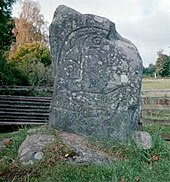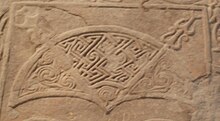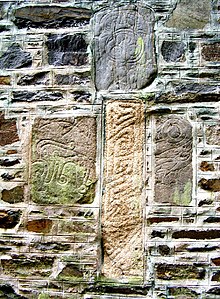Pictish symbol stone
The stone monuments known as Pictish symbol stones ( English Pictish or Sculptured Stones ) are called, originated in the northeastern and northern Scotland mainly between the 5th and 9th century. Chr. And have surely been primarily grave stones, although this is not entirely clear . Around 350 stones are currently known, but new ones are always being discovered, for example in September 2011 on the Black Isle .
Pre-Roman times

In Ireland ornamented were standing stones already in the Iron Age set, from Scotland such monuments of this period are, however, unknown. The art of the last millennium BC BC limited itself in Scotland to the decoration of bronze and pottery. Only from the time of the Roman occupation was sculptured stone found in public space ( Antonine Wall ). The native styles thus initiated help to delimit the territories of the peoples in early medieval Scotland: Picts , Scots , British and Angles .
classification
In “The Early Christian Monuments of Scotland” (1903) J. Romilly Allen and Joseph Anderson classified the stones into three classes. Critics have noted weaknesses in the system, but it is widely used.
- Class 1: unworked stones with incised symbols. There are no cross representations. The stones date from the 6th, 7th and 8th centuries ( symbol stone from High Keillor , Sandness - Shetland).
- Class 2: stones with a more or less rectangular shape with a large cross and symbol on one or both sides. The symbols as well as the Christian motifs are created as a relief and the cross with its surroundings is filled with designs. The stones date from the 8th and 9th centuries.
- Class 3: these stones do not have Pictish symbols. It can be cross slabs, tombstones, or free-standing crosses that date from the 8th or 9th century.
symbolism
- Abstract Pictish Designs

The Picts were native to northern Scotland. In addition to a few naturalistic representations ( Battle of Dunnichen Mere ), the stones show a variety of motifs, including the core symbols that usually appear in pairs and are now referred to as double disc and Z-rod (Alyth church), as well as crescent and V-rod. Many theories have been put forward about the interpretation of symbols. They may include statements about political marriage alliances, records of territorial boundaries, and monuments to dignitaries, but none of the theses are substantiated. This is to be explored in open air museums such as Aberlemno , ( Angus ) and Strathmiglo ( Fife ) and in the museums of Dunrobin, Forfar , Dundee , Inverness and St. Vigeans ( Angus ).
Pict symbols have also been found on the walls of some of the East Wemyss caves in Fife. Bulls were inserted into the walls of Burghead Fort the great Pictish rampart in Moray . The importance of this area with its ports and the rich hinterland is reflected by a number of symbol stones. Nearby is Covesea, the sculptor's cave, named after the carvings on the walls, some of which are Picts. The symbols placed around the cave entrance include the triple oval, the crescent moon and the V-rod. The excavations have shown that this large cave experienced at least two phases of activity, an early one in the first millennium BC. And one in the early Pict period. The northernmost symbol stone is the Wolf-man from Mail, found at Cunningsburgh on Shetland . There are 11 stones on the Orkney. There are only nine in the western half of Scotland. Stones still standing on the road are z. B. Clach Ard on the Isle of Skye and the Maiden Stone at Pitcaple .
distribution
The preserved stones are mainly in Aberdeenshire (20 locations), Angus (14), Inverness (19) and Ross (14).
Dating
In terms of art history, it has been established that the first symbols can be dated to the 6th and 7th centuries (Brandsbutt, Crichie, Inverurie, Kintore Kirkyard , Picardy Stone and Tullich). This is supported by a radiocarbon dating to the middle of the 6th century. In a domestic context , a very raw symbol stone was found at Pool on the island of Sanday , Orkney . The symbols may have previously been applied to organic materials such as wood and leather. So far no trace of color has been found on the stones. Presumably, however, color was used to emphasize the designs.
In the late 8th and 9th centuries, stones ( Maiden Stone , Migvie Stone ) with Christian motifs appear next to the symbols in the Pict area . They show that the Picts had found access to Christian iconography . The biblical story of David was a favorite of the depictions. It is impressively designed on the stone shrine of St. Andrew. Motifs such as Daniel in the lions' den or Paul and Antonius breaking bread in the desert also appear.
Before creating free-standing crosses, the Picts selected large stone tablets ( cross slabs ), which they decorated in detail against the background of the cross. Although Pictish symbolism was compatible with Christianity, it was never placed on the cross.
literature
- J. Stuart: Sculptured Stones of Scotland. Aberdeen 1856.
- RBK Stevenson: Pictish art. In: Frederick Threlfall Wainwright (Ed.): The Problem of the Picts. Melven Press, Perth 1980. ISBN 0-906664-07-1
- RBK Stevenson: Christian sculpture in Norse Shetland. In: Froðskaparrit. Tórshavn 28.1981.9. ISSN 0085-0896
- Charles Thomas: Sculptured stones and crosses from St Ninian's Isle and Papil. In: Alan Small et al. a. (Ed.): St Ninian's Isle and its Treasure. Oxford 1973. ISBN 0-19-714101-3
- Ian Fraser: The Pictish Symol Stones of Scotland
See also
Web links
- Strathclyde University's Pictorial Stone Database (with pictures)
- Aberdeen Council file
- Website about the Picts and their stones (English)
- Video
- Iconography
Individual evidence
- ^ Pictish beast intrigues Highland archaeologists . BBC News, Highlands & Islands, September 14, 2011. Retrieved February 18, 2012.
- ↑ Entry on Sandness in Canmore, the database of Historic Environment Scotland (English)









